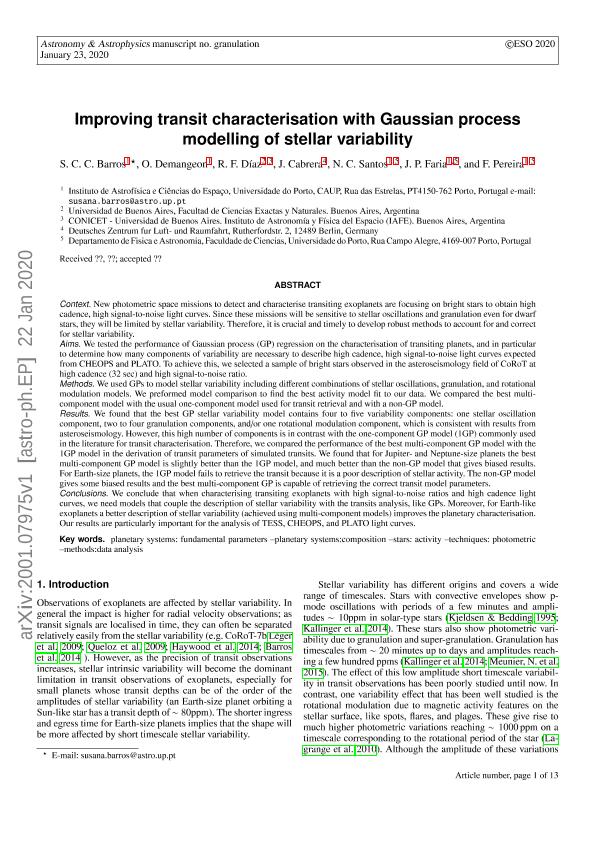Artículo
Improving transit characterisation with Gaussian process modelling of stellar variability
Barros, S. C. C.; Demangeon, O.; Diaz, Rodrigo Fernando ; Cabrera, J.; Santos, N. C.; Faria, J. P.; Pereira, F.
; Cabrera, J.; Santos, N. C.; Faria, J. P.; Pereira, F.
 ; Cabrera, J.; Santos, N. C.; Faria, J. P.; Pereira, F.
; Cabrera, J.; Santos, N. C.; Faria, J. P.; Pereira, F.
Fecha de publicación:
02/2020
Editorial:
EDP Sciences
Revista:
Astronomy and Astrophysics
ISSN:
0004-6361
Idioma:
Inglés
Tipo de recurso:
Artículo publicado
Clasificación temática:
Resumen
Context. New photometric space missions to detect and characterise transiting exoplanets are focusing on bright stars to obtain high cadence, high signal-to-noise light curves. Since these missions will be sensitive to stellar oscillations and granulation even for dwarf stars, they will be limited by stellar variability. Therefore, it is crucial and timely to develop robust methods to account for and correct for stellar variability. Aims. We tested the performance of Gaussian process (GP) regression on the characterisation of transiting planets, and in particular to determine how many components of variability are necessary to describe high cadence, high signal-to-noise light curves expected from CHEOPS and PLATO. To achieve this, we selected a sample of bright stars observed in the asteroseismology field of CoRoT at high cadence (32 s) and high signal-to-noise ratio (S/N). Methods. We used GPs to model stellar variability including different combinations of stellar oscillations, granulation, and rotational modulation models. We preformed model comparison to find the best activity model fit to our data. We compared the best multi-component model with the usual one-component model used for transit retrieval and with a non-GP model. Results. We found that the best GP stellar variability model contains four to five variability components: one stellar oscillation component, two to four granulation components, and/or one rotational modulation component, which is consistent with results from asteroseismology. However, this high number of components is in contrast with the one-component GP model (1GP) commonly used in the literature for transit characterisation. Therefore, we compared the performance of the best multi-component GP model with the 1GP model in the derivation of transit parameters of simulated transits. We found that for Jupiter-and Neptune-size planets the best multi-component GP model is slightly better than the 1GP model, and much better than the non-GP model that gives biased results. For Earth-size planets, the 1GP model fails to retrieve the transit because it is a poor description of stellar activity. The non-GP model gives some biased results and the best multi-component GP is capable of retrieving the correct transit model parameters. Conclusions. We conclude that when characterising transiting exoplanets with high S/Ns and high cadence light curves, we need models that couple the description of stellar variability with the transits analysis, like GPs. Moreover, for Earth-like exoplanets a better description of stellar variability (achieved using multi-component models) improves the planetary characterisation. Our results are particularly important for the analysis of TESS, CHEOPS, and PLATO light curves.
Archivos asociados
Licencia
Identificadores
Colecciones
Articulos(IAFE)
Articulos de INST.DE ASTRONOMIA Y FISICA DEL ESPACIO(I)
Articulos de INST.DE ASTRONOMIA Y FISICA DEL ESPACIO(I)
Articulos(SEDE CENTRAL)
Articulos de SEDE CENTRAL
Articulos de SEDE CENTRAL
Citación
Barros, S. C. C.; Demangeon, O.; Diaz, Rodrigo Fernando; Cabrera, J.; Santos, N. C.; et al.; Improving transit characterisation with Gaussian process modelling of stellar variability; EDP Sciences; Astronomy and Astrophysics; 634; 2-2020; 1-13
Compartir
Altmétricas



